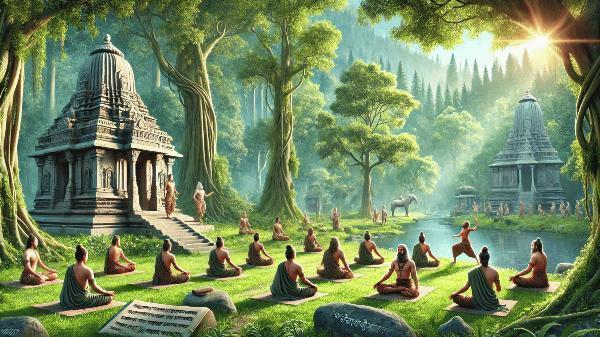The Pre Classical Period of Yoga: A Look Back at Antiquated Methods

Strong 8k brings an ultra-HD IPTV experience to your living room and your pocket.
Yoga is a comprehensive and all-encompassing discipline with thousands of years of history. The intriguing pre classical period of yoga set the groundwork for the practice of yoga as it is known today. Although the more extensively studied classical and post-classical periods frequently cast a shadow over this one, it is essential to comprehend the beginnings and development of yoga.
The Origins of Pre Vedic
We must first examine the pre Vedic period of yoga to comprehend the pre classical period of yoga. The Vedas, which are the oldest texts in Indian history, are older than this era. The practices and ideas that would eventually be institutionalized in the Vedic and classical periods emerged during the pre Vedic period, also known as the proto-Yoga period.
Yoga was not so much a defined discipline as it was an instinctive practice during the pre Vedic era. Earlier ascetics and yogis used physical asanas, breath control, and meditation to transcend ordinary awareness and establish a connection with the holy. These customs were transmitted verbally and were intricately linked to the mystical and spiritual traditions of ancient India.
Pre Classical Times: Connecting the Classical and Ancient Worlds
The transitional era between pre Vedic traditions and Patanjali's classical yoga is known as the pre classical period of yoga. The Upanishads, a body of philosophical writings that examine the nature of reality and the self, have played a significant role in the incorporation of yoga into the Vedic traditions throughout this age.
The composition of the Upanishads, which took place between 800 and 400 BCE, is essential to comprehending the pre classical era. They presented ideas that are fundamental to yoga philosophy, such as the Atman (soul) and Brahman (universal consciousness). These writings expanded on meditation, breath control, and moral discipline techniques (Yamas and Niyamas), laying the groundwork for the more regimented classical yoga schools.
Important Methods and Ideas
In the pre classical era, yoga was essentially an ascetic and spiritual discipline. Important components comprised:
Dhyana (meditation): The foundation of pre classical yoga practice was meditation. Meditation was first utilized by practitioners as a way to clear their minds and reach higher levels of awareness.
Breath Control (Pranayama): It was believed that mastering the breath was crucial to controlling the body and mind. Techniques known as pranayama were created to control energy flow and enhance meditation.
Moral and Ethical Guidelines: The basic versions of the Yamas and Niyamas existed before they were included in Patanjali's Eight Limbs of Yoga. These moral rules made it easier for practitioners to stay focused and disciplined.
Physical Postures (Asanas): To prepare the body for extended periods of meditation, certain physical postures were performed, albeit they were not as important as they were in later centuries.
Transition to Classical Yoga
A major development in the practice was the shift from the pre classical period of yoga to classical yoga. Around 200 BCE, Patanjali formalized classical yoga in the Yoga Sutras, offering a methodical and thorough foundation for yoga practice. Yama, Niyama, Asana, Pranayama, Pratyahara, Dharana, Dhyana, and Samadhi are the Eight Limbs of Yoga, as described by Patanjali, which codified the different forms of yoga practiced in the pre classical era.
The importance of Patanjali cannot be emphasized. Through his systematic arrangement of these practices, he improved the accessibility and comprehension of yoga for the next generations. The foundation of classical yoga was established by the Yoga Sutras, which connected the dots between the prehistoric intuitive practices and the subsequent systematic techniques.
The Post-Classical Period of Yoga
Following the classical era, yoga underwent further development. Around the year 800 CE, the post-classical period of yoga gave rise to several schools and styles of yoga, each with its own interpretations and methods. The advent of Hatha Yoga, the blending of yoga with Tantric traditions, and the expansion of yoga outside of India characterized this period.
Compared to previous eras, the post-classical period of yoga placed more emphasis on breathing exercises (pranayama) and physical postures (asanas). Particularly Hatha Yoga gained popularity due to its emphasis on physical cleansing and meditative readiness.
In summary
The era known as the pre classical period of yoga laid the groundwork for the evolution of yoga into what it is today. We can better understand the lengthy history and development of yoga by delving into the practices and ideologies of this era. Yoga's evolution is evidence of its ongoing relevance and flexibility, from the intuitive practices of the pre Vedic era to the organized systems of classical yoga and the many forms of the post-classical era.
Comprehending the pre classical period of yoga facilitates our connection to the age-old origins of this ageless discipline, serving as a reminder that yoga is a profound spiritual discipline that aims to achieve peace and self-realization rather than only being a physical workout.
Note: IndiBlogHub features both user-submitted and editorial content. We do not verify third-party contributions. Read our Disclaimer and Privacy Policyfor details.



